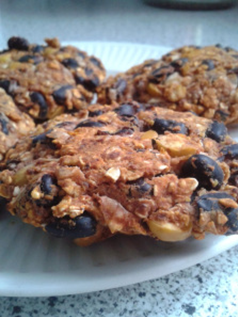Have you heard of tempeh before?
Not so long ago, I had no idea what tempeh was made of, I didn’t know how to pronounce it (for reference, it’s tem-pay), and most importantly, I had no clue why anyone would want to eat it!
In the past few months, that’s all changed. Over the summer, I gradually shifted to a meatless diet. This is not something I’ve advertised, as it’s a bit of an experiment; it’s not something I will necessarily do forever, and I feel like there is a stigma associated with the title “vegetarian”. This change was motivated by a lot of the books I read this summer about modern food systems and how they are largely unsustainable. So I decided to phase out meat for a combination of environmental, ethical, and health reasons – but I’m not going to harp on about that, because I believe that only you can decide what food choices are best for you to make, whether that includes meat or not!
Slightly off-topic: if you want to read a cool book about adopting a part-time meatless diet, I recommend VB6 by Mark Bittman. The title is an abbreviation for his philosophy: eat vegan before 6:00pm (a.k.a. dinner time), and then you can eat whatever animal products you want in the evening. His reasoning behind this philosophy is that by reducing your consumption of animal products, you’ll alleviate the impact of meat production on the environment, but you don’t have to actually give up bacon or cheese or any of the foods you love. It’s an interesting read!
Anyway, back to today’s post: I started to look for meatless protein sources this summer, and tempeh proved to be a great find. Now I really enjoy tempeh, and it’s a great option to add to your Meatless Monday meal rotation. But let’s get back to the basics – what exactly is tempeh?
Considered tofu’s exotic cousin, Tempeh is made from cultured and fermented soybeans, which are bound together in a firm block/cake. It is often associated with tofu, which is also soy-based (tofu is made from coagulated soy milk). However, tempeh differs from tofu in many ways: where tofu is soft and smooth with an egg white-like consistency, tempeh is nutty and chewy. Tempeh’s firm texture makes it an ideal meat substitute in processed vegetarian products, such as for veggie burgers. It is also commonly sold as a meatless bacon substitute at mainstream grocery stores such as Loblaws; the company that makes Tofurky sells a line of these “bacon” strips.

The first time I ever tried tempeh, I was at my favorite salad place, Urban Herbivore. One of their many creative and delicious staples is sesame-glazed tempeh, that can be eaten either in a sandwich or topped on a salad. I tried it on a whim and loved it; it inspired me to look for tempeh in the grocery store so I could make it for myself at home. Unfortunately, most grocery stores I checked only carried the processed tempeh products (not the plain tempeh blocks which consist solely of soybeans, water, and cultures). Out of curiosity, I tried the Smoky Maple Bacon Tempeh strips made by Turtle Island Foods. They tasted pretty good, but they were also expensive and they contained some processed ingredients that I wasn’t familiar with (autolyzed yeast extract, anyone?). I wanted to marinate tempeh myself with simple ingredients from home, and so my quest for a plain block of tempeh continued.
Eventually, I hit a stroke of luck and found tempeh at an organic grocery store called Nature’s Emporium under the brand Henry’s Tempeh. The company offers a few different flavors, but the only ingredients (aside from soybeans, water, and cultures) are simple add-ins such as red pepper, curry, or basil. I’ve tried the original and the red pepper versions, and I don’t find that there is a big flavour difference between them (especially if you end up marinating them anyway).

So you might be wondering at this point…ok, that’s great and all, but…why would I want to even try tempeh? Well, tempeh’s unique flavour and texture can appeal to both meat eaters and non-meat eaters. While tofu often gets a (well-deserved) bad rap for tasting like nothing on its own, tempeh has a pleasant texture even if you eat it plain. It has a mild flavour unless you add a sauce or a glaze, but you can throw it in any kind of dish like a soup or stew and it will absorb the flavour – eliminating your need to pre-marinate it.

Another great thing about tempeh is that the plain tempeh blocks (not the marinated bacon strips) undergo minimal processing. Tempeh may sound like some creepy new “health” food that’s hyper-processed in a factory – but really, it just undergoes a fermenting process. Plus, it’s been around for quite awhile – it originated in Indonesia and the first known reference to it dates back to 1815! Nutritionally speaking, tempeh is a good source of iron and protein – that’s why it works well as a meat substitute for vegetarian dishes. Financially speaking, tempeh isn’t terribly expensive; it’s about $5 for a block of tempeh, but this will make about 2-3 servings.
Tempeh can be eaten raw, cut into strips and baked or fried, or stirred into soups, stews, and salads. My favourite use of tempeh is to marinate it and throw it into salads or pastas – but the possibilities are endless!
Don’t be scared off by tempeh – it’s awesome! As I mentioned before, the best introduction to tempeh is at Urban Herbivore. If you fall in love with it there, it’s easy to make your own tempeh glaze at home too!
And now, for a tempeh marinade recipe! It’s not the Urban Herbivore sesame-based one, but it’s a simple recipe with lots of opportunity for variation. I chose to use curry for this marinade but I’ve also used tandoori masala and garam masala – experiment to find the spice mix that appeals most to you!
1 package of Henry’s Tempeh, sliced into bacon-style strips
2 tbsp of curry powder
2 tbsp of red wine vinegar
2 tbsp low-sodium soy sauce
2 tsp garlic powder
1. Cut the tempeh strips to your desired thickness; I chose to cut them to about ¼ inch thick strips (like thick bacon strips).
2. In a bowl, combine curry powder, vinegar, soy sauce, and garlic powder. Stir to combine. You should have a glaze consistency; if you’d prefer it to be thinner, add a bit more liquid.
3. One by one, dip the tempeh strips in the glaze to coat. Place the prepared strips in a plastic container with a lid; stacking them is fine. Once all the strips are coated, seal the container and leave the strips in the fridge to marinate for 1-8 hours.
4. Once the strips are done marinating, place them in an oiled frying pan and cook on medium heat for about 2-3 minutes per side.
5. Once your strips are prepared, they will keep in the fridge for at least a week and you can incorporate them into all kinds of recipes: pasta, salad, sandwiches, soups, stews, stir-frys…the possibilities are endless!
Stay tuned for a recipe in the future where I’ll show you one of my favourite ways to use tempeh. But for now, that concludes your temp-education 🙂
Happy cooking,
Andie & Erica
Picture sources:









